

By Peter Wilson
In
January 2007 I put my Airnimal in a suitcase and joined Edwin Jones,
the secretary of West Sussex CTC, Martin and Peter on a trip to
Australia. This is well documented on the blog Edwindownunder,
but I took a slightly different route due to being a weak cyclist.
The trip was from Melbourne to Adelaide using the inland route and
returning along the coast.
We
left England and went straight into cycling from Melbourne in 400C
with a head wind and a mountain. I was really suffering with the
heat and arranged to meet the others later. While I was resting by
the roadside a “roadside assistance” van stopped and Phil
assisted me to the motel in Ballarat. We passed Lake Wendouree
where the hot weather and lack of rain caused it to be completely
dry. Yachts and motor boats were resting on dry earth. When the
others arrived they looked shattered after a couple more mountains
and the headwind. All this happened on the first day cycling and
there was another five weeks to go.
After
cycling through a flat area with trees and lots of kangaroos we
stayed in Halls Gap, a mountainous area that had a forest fire the
previous year. We passed burnt trees for about thirty miles but the
vegetation was coming back and the light green leaves contrasted
dramatically with the black tree trunks. When we arrived there were
168 forest fires in Australia. They were caused by thunder and
lightening without rain. The average rainfall for February is 11
millimetres but while we were there we had 100 millimetres in one
day, and this left just four forest fires.
At
Horsham I opted out of a trip across three deserts, against the wind
and very high mileage and booked on a train to Adelaide. The first
part of the trip was a straight run through hundreds of miles of
sandy coloured countryside and I could not distinguish whether it was
sand, dried grass or gathered wheat fields. This contrasted with
the second part of the journey when we crossed from Victoria to South
Australia and the scenery became green with trees. The track led to
the River Murray and the Adelaide Hills. This part was very slow
and tortuous on a single track through heavily wooded steep slopes.
We arrived at Mount Lofty and suddenly there was a view of Adelaide
below us as though we were in an aeroplane. I spent a week there
exploring the cycle tracks leading to the yacht clubs, along the
“linear parks” to the Adelaide hills and the Barossa valley
vineyards. I also visited the city’s many gardens, open spaces
and museums. When it rained I went to a jazz concert.
I
cycled to Wolf Blass for some wine tasting in the commercial town of
Nuriootpa. It was an exceptionally well designed visitor centre,
factory and interiors. Modern design in Australia is a very high
standard and very unique with its corrugated iron cladding and modern
graphics. I felt my entry on a yellow Airnimal Chameleon was not
the sort of customer they wanted. I mentioned I had never had a
poor Australian red wine - this was corrected later - and mistakenly
said I preferred French white wine. I was then subjected to a
lesson straight out of her encyclopaedia of fairy tales on the
difference between the Australian and French wines. There was no
more tasting here and I left to cycle through rolling hills with
their regularly planted vines, small German town of Tanunda town and
the other well known vineyards.
On
Australia day I returned from the coastal towns of Brighton and
Glenelg, to Adelaide to hear numerous roars of the crowd at the
cricket club. When I went to enter the hotel lift a man, dressed in
a pink suit and pink top hat complete with corks on strings, was
gloating at the thrashing they had given the English cricket team.
I caught the next lift. Although our boys were not too good at bat
and ball I wished the mad hatter had seen how on several occasions
Martin cycled straight past the local racing cyclists as they slowly
climbed the hills. His face would have been the same colour as his
suit.
In
Adelaide Edwin decided to take a few hundred night-time photographs
of the lights across the water. We crossed the lawns just as the
sprinklers were starting and dodging them looked like a Monsieur
Hulot film and continued when Edwin did not see the black swans that
were next to him on the black lake as he took his photographs.
The
roads in Australia were very good but they were very narrow and the
buses had to travel with their nearside wheel on the white line in
order not to cross the centre line. It was the same white line that
we followed! We had headwinds for two weeks and the roads were
smooth, black, boring, bituminous and flat with an occasional bend,
adjacent salt lakes and sometimes a roadside tree. We cycled from
oasis to oasis. The road trains were fast and did not slow for
anyone and so when they overtook us they forced oncoming traffic onto
the gravel hard shoulder. On one occasion the other three cyclists
were lost between two trucks as one overtook the road train on the
inside! Fortunately at the rear of the trucks there was a cloud of
dust and out popped the sprinters like rabbits out of a hat.
On
the way to Beachport I was tired, struggling against the wind and
resting frequently. Although people in cars stopped to check that I
had water they were not in cars suitable for a lift, not even for a
folding bike. Previously we had cycled several miles on an unmade
road and this led to a puncture, I found a hole in the tyre, it
started raining and I became a little concerned as an eagle with a
two metre wing span circled above. I finally arrived at the hotel
after the restaurant had closed. The next day I caught the bus from
this one-time whaling station to Mount Gambia. I was relieved to
find it was not a mountain. It was a series of craters with lakes
with connecting underground watercourses through the limestone strata
that formed sink holes where the ground had collapsed. The
limestone filtered the water and left the caves with streams and
lakes of totally clear water that could not be seen and would take
500 years to reach the coast.
I
ordered some new tires from the Australian Airnimal agent, Ian at
Flying Furniture, and they arrived two days later. The conversation
with the man at the post office was a little like a conversation in
‘Allo ‘Allo. I simply could not understand what he was saying
but I was grateful for his help and his colleague for translating
that it was quicker for me to collect than have the parcel delivered
to the motel!
The
incessant headwind that varied from 20 to 35 knots continued along
the route and along the magnificent coast of the Ocean highway. We
visited wild life parks, vineyards, rainforests, salt lakes and
mountains. One day it was raining and I was wet and cold from the
condensation in my water proof jacket, wearing rain soaked soggy
gloves, knickers and socks, however, we then started to see the
magnificent shapes and towering pillars that were formed by the
raging surf eroding the huge ochre coloured limestone cliffs. It
was the surf that led to 700 wrecks. The discomfort became an
irritant. The next day the hot sun and the prevailing wind arrived
and were with us as we cycled next to the sea with a cool breeze and
the smell of seaweed and salt water. We spent hours finding and
watching koalas, brightly coloured parrots and kookaburras. It
became a holiday again rather than an experience. I felt very
envious of the koalas being able to sleep nineteen hours a day.
The
evenings were the time to relax. The television programmes made ITV
seem quite erudite. The news was mainly about cricket, drought and
obesity with a useless rapidly presented weather forecast that Edwin
then had to check on his computer. The bathroom showers were like
standing under a water fall and the meals were large and so we
understood the reasons for the news bulletins, but not why they were
the same every day. We chatted over some very good meals and wines.
As the wine went down Edwin and I were entertained by Martin and
Peter reminiscing and acting as the cabaret. There were days when
the trip was an “experience” but there were many others when it
was a wonderful holiday.
The
language not only has an accent but also one can have a whole
conversation without saying anything. “G’day, how are you, no
worries, no problem, see you soon” If they do see us soon we
would certainly have problems.
There
were two main reasons to go to Australia, to experience the scenery
and to see and hear the wild animals. On the first day I was
pleased to see a red kangaroo and I assumed there would be many more,
but we were in a “gray” area and it was suggested I was
hallucinating as I did not have a signed photograph! Generally wild
animals were not to be seen where there were road signs warning us of
their existence. We saw kangaroos, wombats, koalas, penguins, emus
and many wild birds that we do not see in the UK.
Once
again I am grateful for Edwin and the sprinters allowing me to join
them on their CTC holiday. Although it was a considerable challenge
I certainly enjoyed it as much as the others, but in a very different
way! The only problem I had with my folder was a puncture.


Left: Linear Park with a cycle track along the Torrens River to the Adelaide Hills. Right: Barossa Valley - Wolf Blass visitor reception, wine tasting and bike.
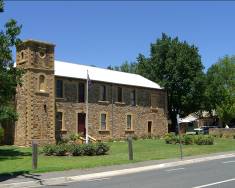

Left: Hahndorf, a Bavarian town in the Adelaide Hills. Right: Smooth, black, boring, bituminous flat road adjacent to a salt lake.
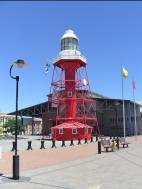
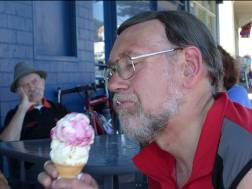
Left: North Port, Adelaide, a well presented tourist attraction. Right: Edwin having lunch in Brighton.
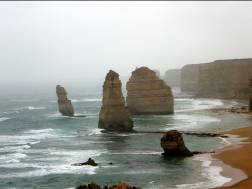
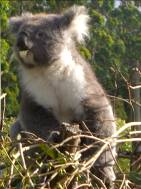
Left: The Limestone Coast. Right: Wild life - but more sleepy than wild.

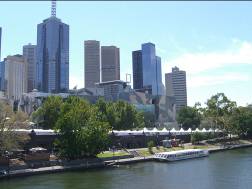
Left: Cyclists in a rainforest. Right: Back in Melbourne.
The author adds: "Peter Wilson cycles with the West Sussex CTC. He has an irregular pulse that makes him a very weak cyclist".